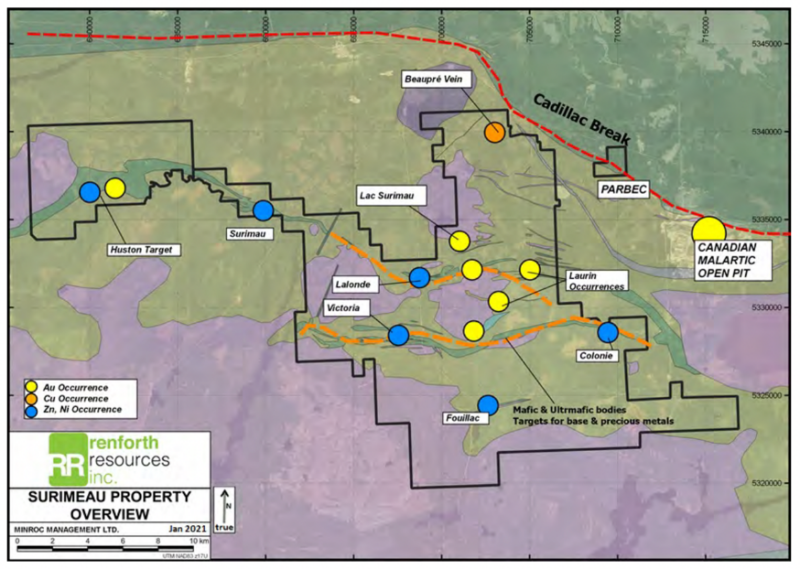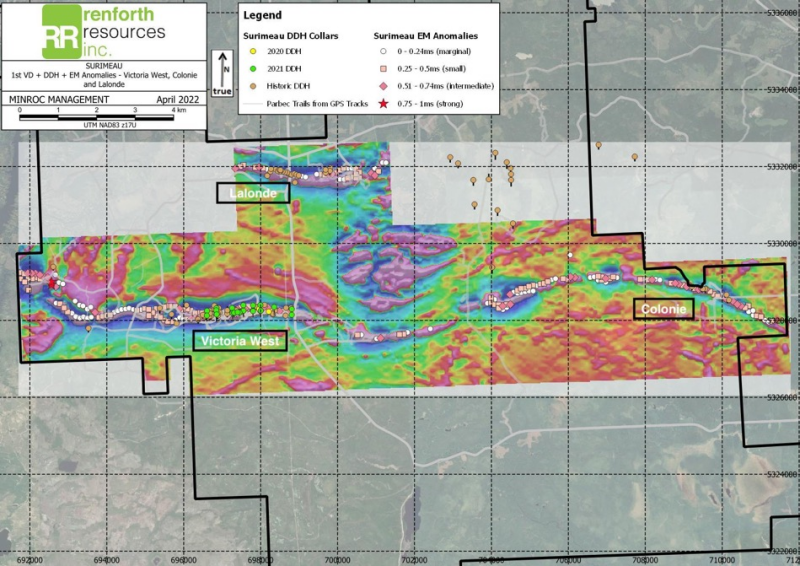RFR.CN RFHRF Renforth Establishes Establishes Surimeau's Lalonde Polymetallic Battery Metals Mineralization Strike at 2.4km
- Current fieldwork discovered surface battery metals sulphides within the northern magnetic structure hosting Lalonde, co-incident with EM anomalies, over 2.4km in E/W strike length
- Lalonde, within Renforth's 330 km Surimeau District Property, is located ~3.7km north of the Victoria West mineralization previously drilled by Renforth over 2.2 km in E/W strike length
- Lalonde has delivered one of Surimeau's best visually mineralized samples, at 50-80% disseminated sulphide (pyrite and sphalerite) with rare coarse pyrite clots within albitized ultramafic rock, visually similar to material channel sampled within the stripped area at Victoria West
- Prospecting success validates the accuracy of EM anomalies indicating the presence of sulphides within magnetic structures at Surimeau
May 31, 2022 – TheNewswire – Ontario, Renforth Resources Inc. (CSE – RFR) (OTCQB– RFHRF) (FSE-9RR) (“Renforth” or the “Company”) is pleased to announce that the Lalonde polymetallic "battery metals" mineralization has been extended to the east by ~1.7km and to the west by ~400m by surface sampling of EM anomalies located on the magnetic structure, bringing Lalonde's strike length to ~2.4km and concluding work at Lalonde in the current program.
"I am happy to report to shareholders that the detailed mag and EM survey we flew over the Victoria structure and the main part of the Lalonde showing at Surimeau successfully shows us the presence of sulphide mineralization within the magnetic structures, as proven by our prospecting work delivering visual mineralization when bedrock outcrop was able to be located by our field team. Now we will wait for the assay results to accompany our visuals and will shortly be planning our next round of field work at Surimeau, to continue building value at Quebec's newest polymetallic battery metals property" states Nicole Brewster, President and CEO of Renforth.
LaLonde Location Within Surimeau

Click Image To View Full Size
History of Lalonde
Renforth, with our focus to date on the Victoria West area and the Victoria magnetic structure, has only done limited work at Lalonde. Like Victoria West, Lalonde was discovered in 1943 during the construction of the powerline for the Rapide Sept generating station south of Surimeau, which in both instances revealed surface mineralization. A total of 2318m was drilled at Lalonde in 1958 and 1968 in 23 drillholes, these were assayed for copper, nickel and zinc, revealing the presence of mineralization. Later drilling took place to the east and northeast of Lalonde; however, these holes were only assayed for gold. At Lalonde, Renforth previously took 34 grab samples during prospecting in 2020 and 2021, each sample demonstrates the presence of elevated copper, nickel, and zinc. The best grab sample results include the highest nickel result, 0.2% Ni, 578 ppm Cu and 785 ppm Zn. This sample is of a silicified sediment with coarse patches of 10-15% sulfide disseminations. In addition, the highest zinc result was 0.56% Zn, 565ppm Cu, 143.5 ppm Ni as well as 3.37 g/t Ag. This sample is of a mineralized rhyolite with coarse stringers of sphalerite and pyrite with approximately 10% sulfide overall. Renforth's prior results from Lalonde are similar to results received from Victoria West. At Surimeau, Renforth interprets the Victoria West/Colonie/Lalonde mineralization to be an "Outokumpu" model of mineralization. Renforth theorizes that ultramafic units were brought into contact with a pre-existing, VMS-fertile stratigraphy providing sulphur to allow for the crystallization of Ni hosting pentlandite alongside the volcanogenic sulphides.
The Outokumpu model is named after a mining district in eastern Finland, a district that has hosted several operating mines in the last 150 years. Current theories suggest that the deposits were formed in two stages. Firstly, conventional “Volcanogenic Massive Sulphide (VMS)” deposit type was created by hydrothermal vents on the sea floor, followed by a tectonic event where ultramafic rocks from the oceanic crust were thrust-faulted into contact with the sedimentary units. These ultramafics commonly carry nickel within silicate minerals in the absence of adequate sulphur in their original magma. During these tectonic events, hydrothermal processes in the faulted contact areas allowed sulphide in the sediments to interact with the ultramafics, permitting the nickel to remobilize and recrystallize in sulphide minerals (pentlandite, pyrrhotite) and thereby adding nickel to the mix of metals carried by the sulphides.
Lalonde Prospecting Map

Click Image To View Full Size
Lalonde Grab Sample

Click Image To View Full Size
Renforth has submitted more than 400 grab samples to the lab in the current program to date. Results will be used to determine follow up locations for hand stripping/channel cutting across the property, as well as to aid in planning future drilling at Surimeau. Results will be released once available however, assay turn-around is still measured in months, not days. Renforth benefits from the sulphides found at Lalonde, Victoria West and Colonie being visual in the samples.
Surimeau Magnetic Survey and EM Anomalies for Lalonde, Victoria West and Colonie

Click Image To View Full Size
Technical disclosure in this press release has been reviewed and approved by Francis R. Newton P.Geo (OGQ#2129), a “qualified person” pursuant to NI 43-101.
For further information please contact:
Renforth Resources Inc.
Nicole Brewster
President and Chief Executive Officer
C:416-818-1393
E: nicole@renforthresources.com
thenewswire.com |








